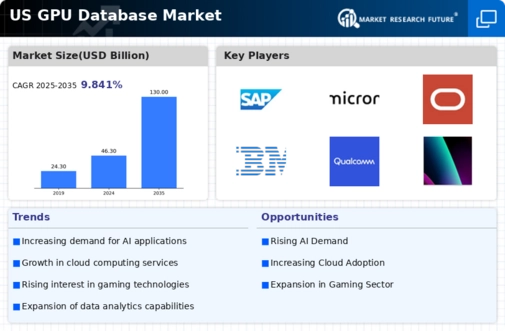The gpu database market is currently characterized by intense competition and rapid technological advancements, driven by the increasing demand for high-performance computing and data analytics. Major players such as NVIDIA (US), Oracle (US), and Microsoft (US) are at the forefront, each adopting distinct strategies to enhance their market positioning. NVIDIA (US) focuses on innovation in GPU architecture, while Oracle (US) emphasizes cloud integration and enterprise solutions. Microsoft (US) leverages its Azure platform to provide scalable database solutions, indicating a trend towards cloud-based services that enhance operational efficiency and data accessibility.
The market structure appears moderately fragmented, with a mix of established giants and emerging players. Key business tactics include localizing manufacturing to reduce costs and optimizing supply chains to enhance responsiveness. This competitive landscape is shaped by the collective influence of these major players, who are increasingly collaborating to address the growing complexities of data management and processing.
In November 2025, NVIDIA (US) announced a strategic partnership with several leading universities to advance research in AI-driven database technologies. This collaboration aims to foster innovation and develop next-generation solutions that could redefine data processing capabilities. The strategic importance of this move lies in its potential to position NVIDIA (US) as a leader in academic and practical applications of GPU databases, thereby enhancing its competitive edge.
In October 2025, Oracle (US) unveiled a new cloud-based GPU database service designed to optimize performance for enterprise applications. This service is expected to significantly reduce latency and improve data retrieval speeds, which are critical for businesses relying on real-time analytics. The introduction of this service underscores Oracle's commitment to enhancing its cloud offerings and responding to the increasing demand for efficient data management solutions.
In September 2025, Microsoft (US) expanded its Azure database services by integrating advanced GPU capabilities, allowing users to leverage AI and machine learning for data analysis. This strategic enhancement not only strengthens Microsoft's position in the cloud market but also reflects a broader trend towards integrating AI technologies into database management systems. Such advancements are likely to attract a wider range of customers seeking innovative solutions.
As of December 2025, the gpu database market is witnessing trends that emphasize digitalization, sustainability, and AI integration. Strategic alliances among key players are increasingly shaping the competitive landscape, fostering innovation and collaboration. The shift from price-based competition to a focus on technological advancement and supply chain reliability is evident, suggesting that future differentiation will hinge on the ability to innovate and adapt to evolving market demands.
























Leave a Comment